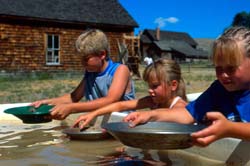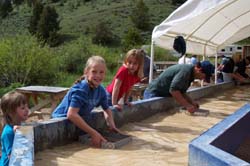Early Mining Techniques
Updated: August 17, 2020

The early miners practiced placer mining. Placer mining is done several ways, but it basically involves searching for loose gold flakes or nuggets near the earth's surface. Gold is a heavy metal. Suppose you scoop a handful of gravel up from a creek bottom with a pan. You'll get a little water in the pan too. Now swish it around so that most of the dirt and rock is washed and then thrown out of the pan. Stop swishing the pan around and if any gold was in that handful of earth, it will come to rest on the bottom of the pan. Men also used rocker boxes. A rocker box looks a bit like a child's crib but was little more than a glorified pan good for handling larger amounts of gravel.

Sluice mining was another popular method. Imagine a long wooden box (the sluice) without a top on it. The box is sitting on a slope. Cleats were put on the inside bottom of the sluice to catch the gold. Gravel was placed in the upper end and then water was poured into the box and allowed to flow through. Gold settled on the bottom of the sluice box. This process usually required several men but they could mine much more efficiently than using a pan or a rocker box.
Other early mining practices included drift mining, hydraulicking, and dredging. Drift miners dug earth out from streambeds creating shafts in the ground several feet deep. Often they would need to divert a stream out of their way. Drift mining recovered gold trapped below the earth's surface. One man would stand down in the shaft and hand buckets of dirt up to another. Hydraulic miners used a high-pressured hose to spray riverbanks clean where they thought they might find gold. Dredges were large complicated steamships which traveled upriver while scooping dirt and gravel from the river bottom. No matter what the method, we call dirt containing precious metal pay dirt.

Material may be protected by copyright law (Title 17 U.S. Code).
Early mining techniques were very inefficient. The discarded dirt, or tailing, contained quite a bit of gold which those miners could never recover with their crude methods. Placer miners were only interested in relatively pure gold or silver. Eventually, most of Montana's surface deposits were worked out. You could no longer just show up, poke around, and find a fortune. Placer mining began to die out only about twenty years after its initial boom. But Montana didn't die with it. By then, Montana was home to thousands of people, many of whom had never mined an ounce of gold.

Society Photograph Archives. Material may be
protected by copyright law (Title 17 U.S. Code).
Slowly, placer mining gave way to quartz mining. As the miners made their way up streams to discover the source of the gold they'd always found washed downstream, they found that it was locked away with other minerals in deposits of ore. Ore is rock with precious metal or other minerals trapped inside. A source of ore was called a lode. You've probably heard the phrase "mother lode." A mother lode is a vein containing large amounts of mineral-rich ore; the "mother" of all the small placer deposits downstream. Quartz mining was much more involved and expensive than placer mining.
Someone equipped with just a pick, a shovel, a pan, and maybe a bucket could begin placer mining alone. Quartz mining required heavy machinery and, usually, many men. Deep shafts were cut out of hillsides. Those shafts were extremely dangerous and sometimes caved in on the men deep inside. Loggers were needed to supply the timbers which supported these shafts. In those old mining communities, the loud sound of a whistle meant that an accident had occurred somewhere down below. Miners dug out ore from inside the shafts and sent it out on carts or hoisted it out in some kind of large bucket. The ore was then crushed in a stamp mill and washed with chemicals, leaving behind pure gold.

Material may be protected by copyright law (Title 17 U.S. Code).
Early quartz miners found that where there was gold, there were often other metals such as silver, copper, or zinc. At first these other metals were considered a nuisance. They made it more difficult to get at the gold. Soon, however, they realized that gold was not the only valuable metal. Silver could be sold to the US Treasury, for example, to be pressed into coins (like silver dollars). As the use of electricity became widespread, copper too became valuable. Wires that carry electricity are made from long copper fibers. The Silver Bow Creek Valley would become an important source of the world's silver and copper ore.
Updated: August 17, 2020

